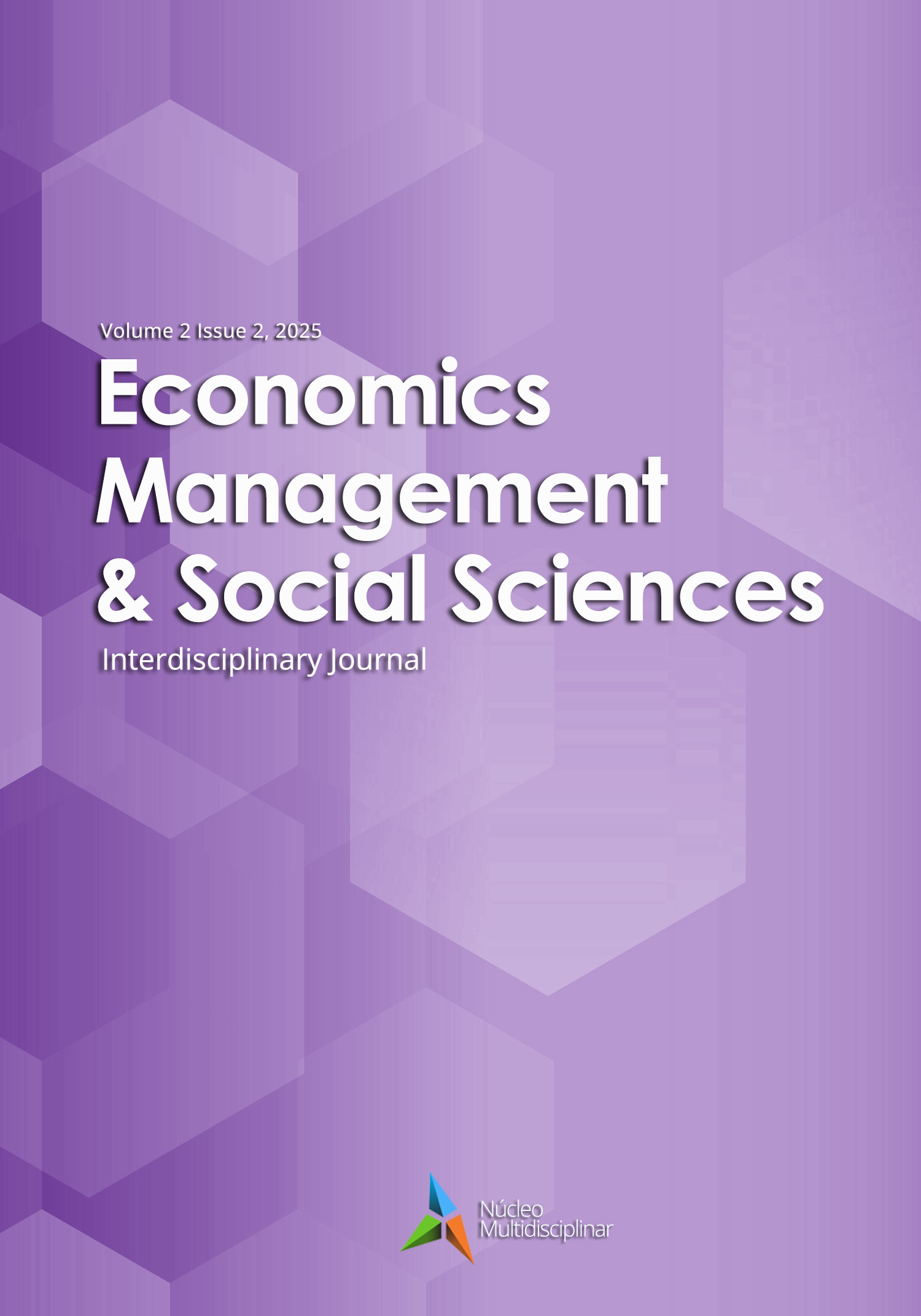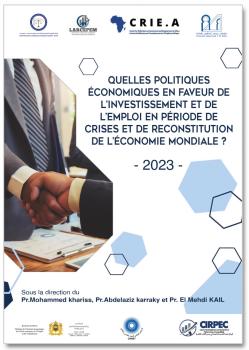L’activité des femmes dans lea pays en développement
Déterminants et impact sur la croissance.
DOI :
https://doi.org/10.23882/emss25158Mots-clés :
L’activité des femmes, Croissance, PED, Données de panelRésumé
La participation des femmes à la population active reste inférieure à celle des hommes, notamment dans les pays en développement (PED) et les régions comme l’Afrique du Nord ou l’Asie du Sud. Cette inégalité, persistante malgré la hausse des revenus, interroge son lien avec le développement économique et les facteurs explicatifs (culturels, religieux, structurels). L’étude vise à analyser cette relation, en testant si la faible intégration des femmes freine la croissance et si des variables comme la religion, les hydrocarbures ou l’éducation influencent leur participation.
Sur la base d’un panel de 91 PED (1990-2018), deux modèles économétriques sont utilisés. Le premier explique la part des femmes dans la population active par le PIB/habitant, l’affiliation religieuse, l’urbanisation, l’éducation et la part des hydrocarbures dans les exportations. Le deuxième modélise la croissance du PIB/habitant, incluant cette fois le taux d’activité féminin comme variable explicative, aux côtés d’indicateurs socioéconomiques et institutionnels.
Les régressions révèlent une relation en U entre participation féminine et PIB/habitant : elle diminue jusqu’à un seuil de 3 100 $, puis augmente. L’affiliation religieuse n’a pas d’impact significatif, contrairement aux hydrocarbures : une hausse de 1 % des exportations d’énergies fossiles réduit de 0,05 point la participation des femmes. En revanche, la croissance économique n’est pas affectée par le taux d’activité féminin dans les modèles testés.
Le développement économique seul ne suffit pas à réduire les inégalités de genre : des facteurs structurels (dépendance aux hydrocarbures) jouent un rôle clé. Les spécificités culturelles ou religieuses sont moins déterminantes que supposé. Enfin, la faible participation des femmes ne semble pas, en soi, freiner la croissance, ce qui interroge les mécanismes par lesquels l’égalité de genre favorise le développement. L’étude souligne la nécessité de politiques ciblées (diversification économique, éducation, lois égalitaires) pour renforcer l’autonomie économique des femmes.
Références
Agénor, P.-R., and O. Canuto. 2015. “Gender Equality and Economic Growth in Brazil: A Long-Run Analysis.” Journal of Macroeconomics 43: 155-172.
Aguayo-Tellez, E. 2011. “The Impact of Trade Liberalization Policies and FDI on Gender Inequalities: A Literature Review.” World Bank Development Report, Background Paper.
Aguayo-Téllez, E., J. Airola, and J. Chinhui. 2010. “Did Trade Liberalisation Benefit Women? The Case of Mexico in the 1990s.” NBER Working Paper No. 16195.
Assaad, R., R. Hendy, and C. Yassine. 2012 “Gender and the Jordanian Labor Market.” Economic Research Forum Working Paper 701.
Baliamoune-Lutz, M. 2007. “Globalisation and Gender Inequality: Is Africa Different?” Journal of African Economies 16(2): 301-348.
Baliamoune-Lutz, M. and M. McGillivray. 2015. “The Impact of Gender Inequality in Education on Income in Africa and the Middle East.” Economic Modelling 47: 1-11.
Bandara, A. 2015. “Economic Cost of Gender Gaps: Africa’s Missing Growth Reserve.” Feminist Economics 21(2): 162-186.
Bandiera, O. and A. Natraj. 2013. “Does Gender Inequality Hinder Development and Economic Growth? Evidence and Policy Implications.” World Bank Policy Research Working Paper 6369.
Bandiera, O., et al. (2020). "Women’s Empowerment in Action: Evidence from a Randomized Control Trial in Africa." The American Economic Review.
Bloom, D. E., Canning, D., fink, g., & finlay, j. E. (2009). Fertility, female labor force participation, and the demographic dividend. Journal of economic growth
Braunstein, E. 2006. “Foreign Direct Investment, Development, and Gender Equity: A Review of Research and Policy.” UNRISD, Occasional Paper 12.
Braunstein, E. 2012. “Neoliberal Development Macroeconomics: A Consideration of its Gendered Employment Effects.” UNRISD research paper 2012-1.
Braunstein, E. 2015. “Economic Growth and Social Reproduction: Gender Inequality as Cause and Consequence.” Background paper for Progress of the World’s Women 2015-16.
Busse, M. and C. Spielmann. 2006. “Gender Inequality and Trade.” Review of International Economics 14(3): 362-70.
Bussmann, M. 2009. “The Effect of Trade Openness on Women’s Welfare and Work Life.” World Development 37(6): 1027-1038.
Costa, J., Silva, E. and F. Vaz. 2009. “The Role of Gender Inequalities in Explaining Income Growth, Poverty, and Inequality: Evidences from Latin American Countries.” International Policy Center for Inclusive Growth Working Paper 52.
Croppenstedt, A., M. Goldstein, and N. Rosas. 2013. “Gender and Agriculture: Inefficiencies, Segregation, and Low Productivity Traps.” World Bank Research Observer 28(1): 79-109.
Cuberes, D. and M. Teignier. 2014. “Gender Inequality and Economic Growth: A Critical Review.” Journal of International Development 26(2): 260-276.
Das, S., S. Jain-Chandra, K. Kochhar, and N. Kumar. 2015. “Women Workers in India: Why So Few Among So Many?” IMF Working Paper WP/15/55.
Dollar, D. and R. Gatti. 1999. “Gender Inequality, Income, and Growth: Are Good Times Good for Women?” World Bank Policy Research Report on Gender and Development, Paper Series, No. 1.
Duflo, E. (2012). "Women Empowerment and Economic Development." Science.
Duflo, E. 2012. “Women, Empowerment, and Economic Development.” Journal of Economic Literature 50(4): 1051–79.
Elborgh-Woytek, K., M. Newiak, K. Kochhar, S. Fabrizio, K. Kpodar, P. Wingender, B.Clements, and G. Schwartz. 2013. “Women, Work, and the Economy: Macroeconomic Gains from Gender Equity.” IMF Staff Discussion Note SDN/13/10.
Elson, S. 2016. “Political Economy of ‘Economic Inequality’ and ‘Gender Inequality.” Paper presented at the IIPPE Conference, Lisbon, Portugal, September.
Esteve-Volart, B. 2004. “Gender Discrimination and Growth: Theory and Evidence from India.” LSE STICERD Research Paper DEDPS 42.
Florence jaumotte (2003), labour force participation of women: empirical evidence on the role of policy and other determinants in oecd countries, oecd economic studies, no. 37
Floro, M. and S. Seguino 2002. “Gender Effects on Aggregate Savings: A Theoretical and Empirical Analysis.” World Bank Policy Research Paper on Gender and Development No. 23.
Forsythe, N., R. Korzeniewicz, and V. Durrant. 2000. “Gender Inequalities and Economic Growth: A Longitudinal Evaluation.” Economic Development and Cultural Change 48(3): 573-617.
Galor, O. and D. Weil. 1996. “The Gender Gap, Fertility and Growth.” American Economic Review 86(3): 374-387.
Hakura, D., M. Hussain, M. Newiak, V. Thakoor, and F. Yang. 2016. “Inequality, Gender Gaps and Economic Growth: Comparative Evidence for Sub-Saharan Africa.” IMF Working Paper WP/16/111.
Heather Antecol(2003), Why is there Cross-Country Variation in Female Labor Force Participation Rates? The Role of Male Attitudes Toward Family and Sex Roles, Department of Economics, Claremont McKenna College
Heintz, J. 2006. Globalisation, Economic Policy and Employment: Poverty and Gender Implications. International Labor Office, Employment Policy Unit, Employment Strategy Department.
I. Gaddis et S. Klasen(2014), Economic development, structural change, and women’s labor force participation : a reexamination of the feminization U hypothesis, Journal of Population Economics
Jayachandran, S. (2021). "Social Norms as a Barrier to Women’s Employment in Developing Countries." Journal of Economic Perspectives.
Johannes P. Jütting , Christian Morrisson , Jeff Dayton‐Johnson & Denis Drechsler(2008), Measuring Gender (In)Equality : The OECD Gender, Institutions and Development Data Base, Journal of Human Development
Kabeer, N. and L. Natali. 2013. “Gender Equality and Economic Growth: Is There a Win-Win?” IDS Working Paper, Volume 2013, No. 417.
Kazandjian, R. L. Kolovich, K. Kochhar, and M. Newiak. 2016. “Gender Equality and Economic Diversification.” IMF Working Paper WP/16/140.
Khera, P. 2016. “Macroeconomic Impacts of Gender Inequality and Informality in India.” IMF Working paper WP/16/16.
Klasen, S. 1999. “Does Gender Inequality Reduce Growth and Development? Evidence from Cross-Country Regressions.” World Bank Policy Research Report, Engendering Development Working Paper No. 7.
Klasen, S., and F. Lamanna. 2009. “The Impact of Gender Inequality in Education and Employment on Economic Growth: New Evidence for a Panel of Countries.” Feminist Economics 15(3): 91–132.
Knowles, S., P. Lorgelly, and D. Owen. 2002. “Are Educational Gender Gaps a Brake on Economic Development? Some Cross-Country Empirical Evidence.” Oxford Economic Papers 54(1): 18–149.
Kongar, E. 2007. “Importing Equality or Exporting Jobs? Competition and Gender Wage and Employment Differentials in US manufacturing.” In I. van Staveren, D. Elson, C. Grown, and N. Cağatay, eds., The Feminist Economics of Trade. London: Routledge, pp. 215–236.
Löfström, A. 2012. “Gender Equality, Economic Growth and Employment.” Swedish Ministry of Integration and Gender Equality.
M. R. Killingsworth et J.Heckman (1986), Female labor supply: a survey, in Handbook of Labor Economics, Volume I, Edited by O. Ashenfelter and R. Layard
Morrison, A., R. Dhushyanth, and N. Sinha. 2007. “Gender Equality, Poverty, and Economic Growth.” World Bank Policy Research Working Paper 4349.
Olivetti, C., & Petrongolo, B. (2017). "The Economic Consequences of Family Policies." The Quarterly Journal of Economics.
Rendall, M. 2013. “Structural Change in Developing Countries: Has it Decreased Gender Inequality?” World Development 45: 1-16.
Rodrik, D. 2016. “Premature Deindustrialization.” Journal of Economic Growth 21(1): 1-33.
Seguino, S. 2000b. “Gender Inequality and Economic Growth: A Cross-Country Analysis.” World Development 28(7): 1211-1130.
Seguino, S. 2016. “Global Trends in Gender Equality.” Journal of African Development
Seguino, S. and M. Floro. 2003. “Does Gender Matter for Aggregate Saving? An Empirical Analysis.” International Review of Applied Economics 17(2): 147–66.
Seguino, S. and M. Were. 2014. “Gender, Development, and Growth in sub-Saharan Africa.” Journal of African Economies 23 (supplement 1): i18-i61.
Sher Verick (2014), Female labor force participation in developing countries, International Labour Organization, India, and IZA, Germany
Stella tsani, Leonidas paroussos, Costas fragiadakis, Ioannis charalambidis and Pantelis capros (2012), Female labour force participation and economic development in southern mediterranean countries: what scenarios for 2030? Medpro technical report no. 19
Stockhammer, E., Ö. Onaran, and S. Ederer. 2009. “Functional Income Distribution and Aggregate Demand in the Europe Area.” Cambridge Journal of Economics 33(1): 139-159.
Stotsky, J., S. Shibuya, L. Kolovich, and S. Kebhaj. 2016. “Trends in Gender Equality and Women’s Advancement.” IMF Working Paper WP/16/21.
Tejani, S. and W. Milberg. 2016. “Global Defeminization? Industrial Upgrading, Occupational Segmentation and Manufacturing Employment in Middle-Income Countries.” Feminist Economics 22(2): 24-54.
Woetzel, J., et al. (2015). "The Power of Parity: How Advancing Women’s Equality Can Add $12 Trillion to Global Growth." McKinsey Global Institute.
World Bank. 2011. World Development Report 2012: Gender Equality and Development. Washington, D.C.: The World Bank.
Téléchargements
Publiée
Comment citer
Numéro
Rubrique
Licence
(c) Tous droits réservés Hamid FAYOU, Sadek EL BOUSSAIRI, Nabil BOUBRAHIMI, Lahcen OULHAJ 2025

Ce travail est disponible sous licence Creative Commons Attribution - Pas d’Utilisation Commerciale 4.0 International.







